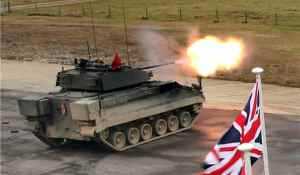
LEICESTER, United Kingdom -- British Army Warrior infantry fighting vehicles are set for a major boost in combat effectiveness by 2013 if a BAE Systems bid to upgrade the fleet is successful.
The bid, submitted a day before the 18 Nov deadline, is for the £1bn Warrior Capability Sustainment Programme (WCSP), which will provide the mainstay of the Infantry’s frontline fleet in Afghanistan and future conflicts. It features a new turret and weapon system to increase firepower; a fully digital ‘operating system’ to improve fightability and survivability, and allow plug-and-play future upgrades; and a modular armour system for quick and simple adjustments to protect against ever-changing threats.
BAE Systems has invested over £40m of its own money in developing the new gun, turret and electronic architecture to ensure the equipment can be delivered to the front line on time and to budget.
Jan Söderström, managing director of BAE Systems’ Vehicles business, explains the thinking behind its decision to opt for an all-new turret.
“As the manufacturer of Warrior, we took the view that modifying the existing turret was not a satisfactory solution as it could raise safety issues. Instead we have developed a completely new design which fully meets the UK Ministry of Defence’s protection requirements and has many similarities with our FRES Scout turret to maximise the benefits of commonality in areas such as training and logistics.”
The front of BAE Systems’ FRES and Warrior turrets are very similar - the gunner crew station is identical - and feature optimised crew stations and large hatches designed to accommodate today’s and tomorrow’s soldier wearing full Osprey body armour. (Soldiers are getting bigger and crew positions in many existing vehicles are becoming too cramped to accommodate them or allow easy exit from the vehicle in an emergency).
The BAE Systems turret design is also optimised for the all-new weapon system (CT40) mandated by the UK MoD for Warrior and FRES SV. The ammunition is carried low to optimise performance, crew safety and the highly-reliable feed system can be accessed from under armour. It is based on the highly successful MTIP2 programme which saw the BAE Systems CT40 turret, mounted on Warrior, fire on the move over a period of four months in 2008.
The CT40 weapon system and turret’s ease of use, ability to fire on the move, versatility and much-increased punch means that it will give a major improvement over the 30mm Rarden gun currently used in Warrior. It fires a one-kilo high-explosive round which has three times the terminal effect of the Rarden shell and can be detonated in mid-air above the target to attack troops behind cover.
BAE Systems has delivered well over 40 Urgent Operational Requirements (UORs) for Warrior in the last five years, many of them working closely with the Defence Support Group, and this experience has also fed into two other areas of its bid – the Enhanced Electronic Architecture (WEEA) and the Modular Protection System (WMPS).
WEEA is very similar to the electronic architecture BAE Systems is offering for FRES SV and is genuinely open architecture, “future-proofing” the vehicle and allowing simple integration of new or upgraded systems from any vendor.
WMPS will provide a ‘productionised’ mounting system for the various armour fits developed for the Iraq and Afghanistan conflicts under UORs and allow quick changes to meet new threats. BAE Systems has also developed a new blast-attenuating driver’s seat to further improve earlier UOR mine protection measures, such as a new belly plate and stiffer suspension to restore the vehicle’s ride height.
“All these changes have to be managed in a holistic way,” says Warrior campaign director Judith Eastwood. “For instance, as Warrior weight has grown, we have developed better brakes. These generate extra heat, which has to be managed to avoid knock-on effects.
“We have 30 years’ experience of Warrior, so we understand it as a system and can provide and support a technically superior, affordable WCSP solution that will meet the needs of the British Army for the next 25 years.”
Under WCSP 643 vehicles will receive WEEA and WMPS. 449 of them will also get the new turret and weapon system under the WFLIP (Warrior Fightability and Lethality Improvement Programme). The remaining vehicles will carry out other roles including repair and recovery.
BAE Systems
19.11.2009